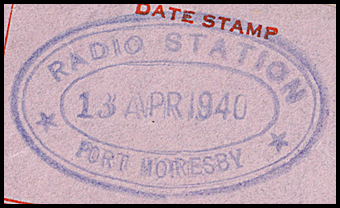Island Radio Service - Papua New Guinea Stations.
- Australia 1901-1988
- New South Wales
- Queensland
- South Australia
- Tasmania
- Victoria
- Western Australia
- International
- Special aspects
The stations included below are:
| Call sign: VIG | |
| Opened: 26 February 1913. | Closed: Transferred to OTC in 1947. |
| Location: The original station was built about 2.5 km at Wonga. | |
| Transferred to: Wonga (about 8 km inland) during World War 2. | |
Size: 26 × 44 mm. Used on IAA-DR-3. |
| Call sign: VIU | |
| Opened: June 1915 | Closed: 23 January 1942 - station abandoned due to hostilities and destroyed "by being put to the torch". |
| Location: On Bougainville Island which had few people whose number included government officials, planters, Burns Philp guests and a few permanent residents. The station was a one-man operation. |
|
The station was equipped with a short-wave receiver, a transmitter and a telephone to facilitate contact with district officers and residents.
A boat brought supplies and mail every 6 weeks. There was a shop which doubled as the hotel and a tennis court.
The Brisbane Courier of 10 June 1915 reported:
Radio Station at Bougainville:
"The Deputy Postmaster-General advises that a radio telegraph station has been opened at Kieta (Bougainville), Solomon Islands, for the transaction of a limited amount of public correspondence between the hours of 7 p.m. and 10 p.m. The rates payable will be the Commonwealth landline charges plus 3d. per word for the wireless charge. Messages will be routed via Townsville radio station. It is added that private traffic may be subject to delay".
| Call sign: VIJ | |
| Opened: September 1917. | Closed: |
| Location: A small island at the entry port for ships travelling to the eastern and south-eastern parts of Papua. | |
| Transferred: In January 1942, most of the radio equipment was dismantled and transferred to Port Moresby. After the war, Samarai was re-opened but then taken over by OTC in 1947. | |
Built by the Royal Australian Navy.
The station maintained contact with Cooktown, Rabaul and Port Moresby although all traffic for the Australian mainland was sent via Townsville.
The rates were the same as for Port Moresby. Radio land traffic was to be routed via the Cooktown radio. The acceptance of the messages was limited to urgent important matters.
